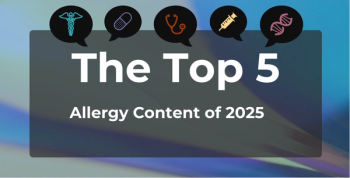
Pediatric Food Allergy Diagnosis Could Be Streamlined By New Scoring System
Key Takeaways
- The NAPFA score integrates clinical features to streamline pediatric food allergy diagnosis, potentially reducing delays and costs.
- Food allergies affect 8% of children under 5, with diagnostic delays posing psychological and economic burdens.
A newly developed Naples Pediatric Food Allergy grading scale, incorporating clinical history and examination, shows promise in streamlining the diagnosis of food allergies in children, potentially reducing delays and health care burdens.
Pediatric patients with food
Immunoglobulin E (IgE) antibodies’ reaction with certain foods causes food allergies, one of the most common chronic conditions among children.1,2 About 8% of children under 5 years old have food allergies, with some resolving in childhood and others typically lifelong.2 The 9 most common food allergies in the US are milk, eggs, wheat, soybeans, tree nuts, peanuts, fish, shellfish, and sesame.
Diagnostic delays, especially for non–IgE-mediated food allergies (estimated at up to 6 months), represent one of the major challenges in pediatric food allergies.1 Delays can cause psychological and economic burdens for both patients and the health care system. This challenge urgently calls for tools that can aid diagnostic approaches for pediatric food allergies without excessive reliance on testing.
Researchers performed a prospective study at the Tertiary Care Center for Pediatric Allergy, Gastroenterology, and Nutrition of the Department of Translational Science. The overall study goal was to develop and internally validate a clinical scoring system for facilitating the diagnostic approach in pediatric patients with suspected food allergy.
Researchers enrolled 627 individuals in the study between January 2023 and December 2023, and these individuals underwent anamnestic and clinical evaluation, including skin prick tests, atopy patch tests, or food-specific serum IgE level measurement, and a 4-week elimination diet. The median age at symptom onset was 8 months.
The study authors developed a multivariable regression model (M1) using food allergy as the outcome, and the following predictors were sex, age of onset, cesarean delivery, occurrence of atopic dermatitis before onset of food allergy, family history, symptoms following ingestion, skin symptoms, gastrointestinal symptoms, respiratory symptoms, and systemic symptoms. A further multivariable regression model (M2) replaced the occurrence of symptoms after food ingestion with the results of allergy tests.
A 4-week elimination diet resulted in a complete resolution of signs and symptoms, potentially related to food allergy, in 368 patients. The most common food allergens were cow’s milk (60.1%), hen’s egg (26.2%), nuts (14%), legumes except for soy (7.6%), fruits (6.7%), fish (6.1%), soy (5.5%), wheat (5.5%), peanuts (5.2%), meat (3.7%), and rice (3.7%).
Children negative at the diagnostic oral food challenge (n = 40) received diagnoses of unrelated atopic dermatitis (n = 10), acute urticaria (n = 12), functional abdominal pain (n = 7), functional vomiting (n = 5), celiac disease (n = 4), and hereditary angioedema (n = 2). An additional 259 children did not respond to the diagnostic elimination diet, and common diagnoses included celiac disease (n = 30), functional diarrhea (n = 32), unrelated atopic dermatitis (n = 53), acute urticaria (n = 71), and more.
M1 (optimism-corrected c-statistic, 0.915; 95% CI, 0.895-0.937) and M2 (optimism-corrected c-statistic, 0.977; 95% CI, 0.969-0.992) models demonstrated discrimination larger than the hypothesized one (0.810). Overall, both models demonstrated good internal calibration and a favorable decision analysis curve.
Previous research relied on the Consortium for Food Allergy Research (CoFAR) grading scale to diagnose food allergies, and more recently, the FDA determined the system was too subjective for wide-scale use.3 The revised version covers the full spectrum of potential allergic reactions, including cutaneous, conjunctival, gastrointestinal, upper and lower respiratory tract, and cardiovascular symptoms. The grading scale has not received validation, and future research must compare existing scales to each other.
The NAPFA is the first scoring system to incorporate anamnestic and clinical features that facilitate the diagnostic approach of pediatric food allergy.1 Its accuracy and feasibility can enable its application in various health care settings, with the potential to reduce health care costs and wait times, once externally validated.
“We are developing a web app that will enhance the model's accessibility and implementation in clinical practice by easily running NAPFA on computers and mobile devices of interested practitioners,” study authors concluded.
References
1. Carucci L, Biancardi L, Nocerino R, et al. The Naples Pediatric Food Allergy (NAPFA) score: a multivariable model for the prediction of food allergy in children. Pediatr Allergy Immunol. 2025;36(4). doi:10.1111/pai.70071
2. Food allergies in children and babies. Johns Hopkins Medicine. 2019. Accessed May 7, 2025.
3. Chinthrajah RS, Jones SM, Kim EH, et al. Updating the CoFAR grading scale for systemic allergic reactions in food allergy. J Allergy Clin Immunol. 2022;149(6):2166-2170.e1. doi:10.1016/j.jaci.2021.12.789
Newsletter
Stay ahead of policy, cost, and value—subscribe to AJMC for expert insights at the intersection of clinical care and health economics.







































